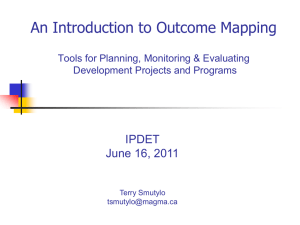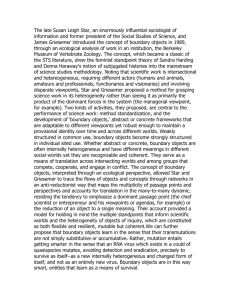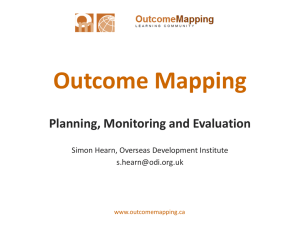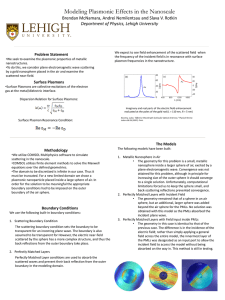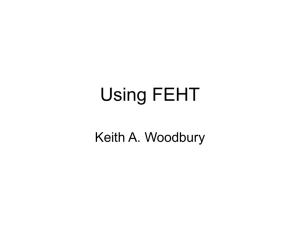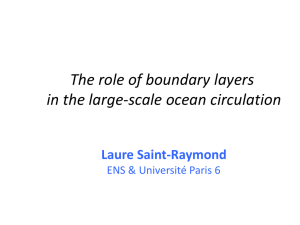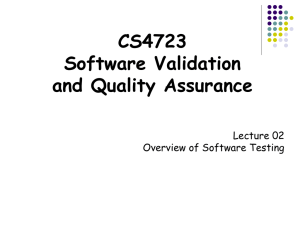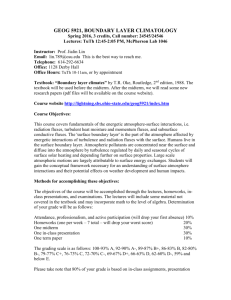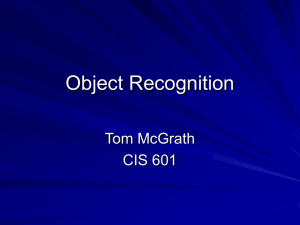Introduction to OM for evaluators: One day workshop
advertisement
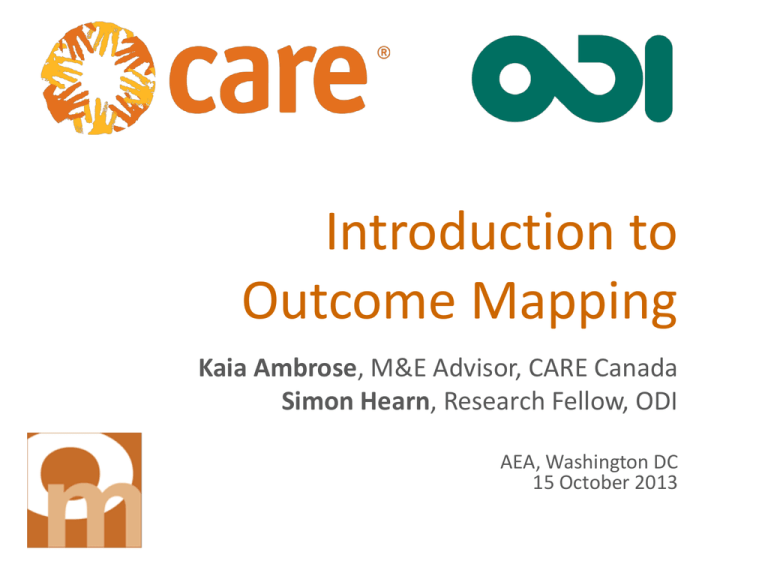
Introduction to Outcome Mapping Kaia Ambrose, M&E Advisor, CARE Canada Simon Hearn, Research Fellow, ODI AEA, Washington DC 15 October 2013 Workshop Objectives Clarify what Outcome Mapping is and does Introduce and apply Outcome Mapping concepts and tools for M&E (with a specific focus on two innovative steps) Consider if and how Outcome Mapping could be useful in our work Agenda Overview This morning: • Key concepts • Use in M&E • Boundary Partners This afternoon: • Progress Markers • Examples of organizations doing M&E with OM • Reviewing OM Origins and principles of Outcome Mapping Acknowledgements This presentation makes use of various materials that were shared by members of the global OM community. Without being exhaustive, special thanks goes to Terry Smutylo, Steff Deprez, Jan Van Ongevalle, Robert Chipimbi, Daniel Roduner and many others. Source: A guide for project M&E: IFAD Conventional thinking… Time Source: Ricardo Wilson-Grau (inspired by Jeff Conklin) … clashes with relationships of cause and effect that are unknown Time Source: Ricardo Wilson-Grau (inspired by Jeff Conklin) Social change can be… • Complex: • Unstable: involve a confluence of actors and factors independent of project duration • Non-linear: • Two-way: unexpected, emergent, discontinuous intervention may change • Beyond control: but subject to influence • Incremental, cumulative: watersheds & tipping points Source: Terry Smutylo Time Source: Ricardo Wilson-Grau (inspired by Jeff Conklin) Brief definition of OM • A participatory method for planning, monitoring and evaluation • Focused on changes in behaviour of those with whom the project or program works • Oriented towards social & organizational learning OM’s answer Start from observable behaviour change Embrace different perspectives Recognise that all interventions have limited influence Support people to build their own well-being Enable interventions to adapt as they engage Apply a systems understanding Source: Terry Smutylo / OM Lab 2012 “Being attentive along he journey is as important as, and critical to, ariving at the destination ” Michael Quinn Patton Three key concepts in OM: 1. Sphere of influence 2. Boundary Partners 3. Outcomes understood as changes in behaviour There is a limit to our influence Project Sphere of control People the project works with/through Sphere of influence People who benefit from the project Sphere of concern Who are your boundary partners? Programme Beneficiaries Stakeholders Boundary Partners Overview of OM • Step 1: What is the intervention concerned about? Vision • Step 2: What does the intervention consist of? Mission • Steps 3 & 4: What would success look like? Boundary Partners • Step 5: What would indicate progress? Progress Markers • Step 6: What strategies will support change? Strategy Map • Step 7: What keeps the intervention relevant, competent and viable? Organizational Practices Reflection: What kinds of information needs do you have? 5 kinds of M&E Information Contextual InformatIon Program Partner Change in economic/ social well-being Strategies outcomes relevance & viability (behaviour changes in the (actions of the program) partners) implementation (interventions by the program) Focus on: Boundary Partners Boundary Partner Exercise • • • • Imagine we have already done a vision and mission Note the stakeholder on your button. Read the two project descriptions. Think about what your primary concern is from the perspective of your stakeholder (imagination!) – Who do you have direct contact with? – Who can you hope to influence change in (that will contribute to your primary concern)? • Go stand next to that person (s). = your boundary partner = your boundary partner’s boundary partner Boundary Partner re-cap • For clarifying intent: who do we need to work with to affect change? Who do we have direct contact with and who do THEY have direct contact with? • For evaluative practice: clarify who we need to collect evidence from; deepening understanding of relationships Q&A Focus on: Progress Markers Progress Markers Love to see (Deep transformation) Like to see (Active engagement) Expect to see (Early positive responses) Love to see Like to see Like to see Like to see Like to see Like to see Expect to see Expect to see Like to see Expect to see How can we measure: Greater awareness… Empowered women… Community ownership… Reduced conflict… Increased collaboration… Governmental commitment… Gender sensitivity… Equal access… Budgetary transparency… Active participation… Poverty alleviation… Strengthened capacity… ? Exercise: Arranging and assessing Progress Markers Progress Marker exercise 1. Arrange the eight Progress Markers into three categories (expect, like, love) [10 mins] 2. Interview the nominated Boundary Partner [15 mins] a. How have their actions/relationships/activities changed? b. What happened as a result? c. What contributed to that change? 3. Write an Outcome Journal describing [15 mins] a. The changes b. The contributors c. The implications for the project Tools for M&E Outcome Monitoring Engendering Change Mid-Term Review Purpose: • Produce strong and quality data that will provide sufficient evidence to assess the Engendering Change program; • Support and strengthen partners’ ability to identify and monitor changes in organizational capacity on gender equality and women’s rights; • Create an action-oriented, participatory monitoring and evaluation space for partners. Guiding Questions: A. Is our model of Capacity Building effective in the program? If so (not), how and why? B. What do strong, effective and gender just organizations look like? C. How do stronger, more gender-just organizations do better, more effective programming? Concepts used from OM CONTRIBUTION SPHERES OF INFLUENCE OUTCOMES BOUNDARY PARNTERS Steps used from OM MISSION STATEMENTS OUTCOME CHALLENGES PROGRESS MARKERS Stories of significant change • Gathered in a workshop journal • 94 stories - internal significant change • 83 - societal significant change Table 2: Functional Areas Matrix for Placement of ‘Significant Change’ Stories Functional Areas Type of Change Organizational Societal Leadership Internal Structure Program Delivery External Relations Use of findings from the review • Integrated use of guiding questions in journals to on-going monitoring of program • Partners using certain techniques for their own purposes • Adjusted and adapted our model of capacity building and supported tool based on findings • Critical enablers as broader indicators for the program Community leaders Network member District official Illegal loggers National media CSO (TFCG) Government department CSO CSO CSO CSO CSO KPMG DFID example… AcT Tanzania Partners monitoring PMs Progress Marker Observations Politicians work with / convince civil servant and appointed officials to publish expenditure reports. In two wards of xxxx and xxxx district councillors have been working with a team of civil servants (i.e. WEOs and VEOs) in preparing ward budget and expenditure reports. These reports were shared with the village communities, and the councillors are playing an active role in ensuring this happens quarterly. Community members speak out in front of leaders with no fear of the consequences. In xxxx village community members were observed not to fear speaking in front of leaders. This was observed during the District Commissioner’s visit in the area, particularly when they told her they are not happy with the new land plan in which some of villagers’ land has been annexed to dispensary area. Anecdote as evidence
